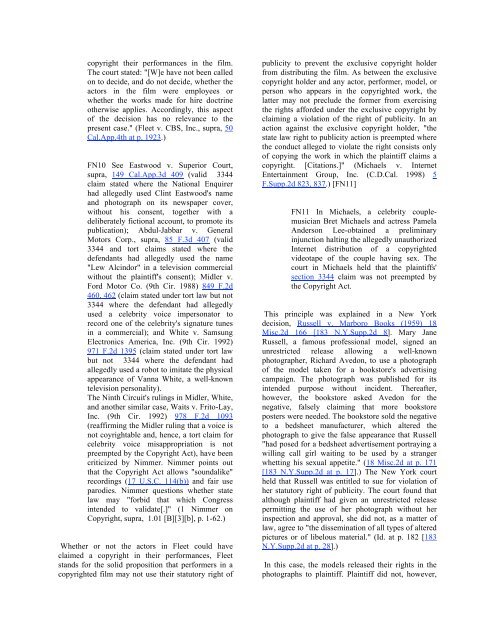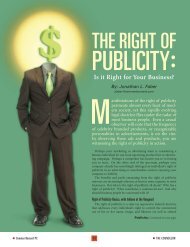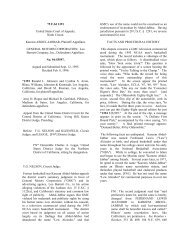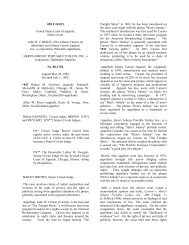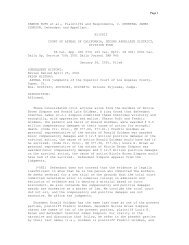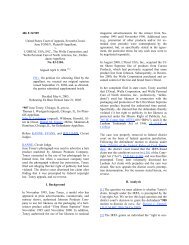KNB ENTERPRISES, Plaintiff and Appellant, v ... - Right Of Publicity
KNB ENTERPRISES, Plaintiff and Appellant, v ... - Right Of Publicity
KNB ENTERPRISES, Plaintiff and Appellant, v ... - Right Of Publicity
You also want an ePaper? Increase the reach of your titles
YUMPU automatically turns print PDFs into web optimized ePapers that Google loves.
copyright their performances in the film.<br />
The court stated: "[W]e have not been called<br />
on to decide, <strong>and</strong> do not decide, whether the<br />
actors in the film were employees or<br />
whether the works made for hire doctrine<br />
otherwise applies. Accordingly, this aspect<br />
of the decision has no relevance to the<br />
present case." (Fleet v. CBS, Inc., supra, 50<br />
Cal.App.4th at p. 1923.)<br />
FN10 See Eastwood v. Superior Court,<br />
supra, 149 Cal.App.3d 409 (valid 3344<br />
claim stated where the National Enquirer<br />
had allegedly used Clint Eastwood's name<br />
<strong>and</strong> photograph on its newspaper cover,<br />
without his consent, together with a<br />
deliberately fictional account, to promote its<br />
publication); Abdul-Jabbar v. General<br />
Motors Corp., supra, 85 F.3d 407 (valid<br />
3344 <strong>and</strong> tort claims stated where the<br />
defendants had allegedly used the name<br />
"Lew Alcindor" in a television commercial<br />
without the plaintiff's consent); Midler v.<br />
Ford Motor Co. (9th Cir. 1988) 849 F.2d<br />
460, 462 (claim stated under tort law but not<br />
3344 where the defendant had allegedly<br />
used a celebrity voice impersonator to<br />
record one of the celebrity's signature tunes<br />
in a commercial); <strong>and</strong> White v. Samsung<br />
Electronics America, Inc. (9th Cir. 1992)<br />
971 F.2d 1395 (claim stated under tort law<br />
but not 3344 where the defendant had<br />
allegedly used a robot to imitate the physical<br />
appearance of Vanna White, a well-known<br />
television personality).<br />
The Ninth Circuit's rulings in Midler, White,<br />
<strong>and</strong> another similar case, Waits v. Frito-Lay,<br />
Inc. (9th Cir. 1992) 978 F.2d 1093<br />
(reaffirming the Midler ruling that a voice is<br />
not coyrightable <strong>and</strong>, hence, a tort claim for<br />
celebrity voice misappropriation is not<br />
preempted by the Copyright Act), have been<br />
criticized by Nimmer. Nimmer points out<br />
that the Copyright Act allows "soundalike"<br />
recordings (17 U.S.C. 114(b)) <strong>and</strong> fair use<br />
parodies. Nimmer questions whether state<br />
law may "forbid that which Congress<br />
intended to validate[.]" (1 Nimmer on<br />
Copyright, supra, 1.01 [B][3][b], p. 1-62.)<br />
Whether or not the actors in Fleet could have<br />
claimed a copyright in their performances, Fleet<br />
st<strong>and</strong>s for the solid proposition that performers in a<br />
copyrighted film may not use their statutory right of<br />
publicity to prevent the exclusive copyright holder<br />
from distributing the film. As between the exclusive<br />
copyright holder <strong>and</strong> any actor, performer, model, or<br />
person who appears in the copyrighted work, the<br />
latter may not preclude the former from exercising<br />
the rights afforded under the exclusive copyright by<br />
claiming a violation of the right of publicity. In an<br />
action against the exclusive copyright holder, "the<br />
state law right to publicity action is preempted where<br />
the conduct alleged to violate the right consists only<br />
of copying the work in which the plaintiff claims a<br />
copyright. [Citations.]" (Michaels v. Internet<br />
Entertainment Group, Inc. (C.D.Cal. 1998) 5<br />
F.Supp.2d 823, 837.) [FN11]<br />
FN11 In Michaels, a celebrity couplemusician<br />
Bret Michaels <strong>and</strong> actress Pamela<br />
Anderson Lee-obtained a preliminary<br />
injunction halting the allegedly unauthorized<br />
Internet distribution of a copyrighted<br />
videotape of the couple having sex. The<br />
court in Michaels held that the plaintiffs'<br />
section 3344 claim was not preempted by<br />
the Copyright Act.<br />
This principle was explained in a New York<br />
decision, Russell v. Marboro Books (1959) 18<br />
Misc.2d 166 [183 N.Y.Supp.2d 8]. Mary Jane<br />
Russell, a famous professional model, signed an<br />
unrestricted release allowing a well-known<br />
photographer, Richard Avedon, to use a photograph<br />
of the model taken for a bookstore's advertising<br />
campaign. The photograph was published for its<br />
intended purpose without incident. Thereafter,<br />
however, the bookstore asked Avedon for the<br />
negative, falsely claiming that more bookstore<br />
posters were needed. The bookstore sold the negative<br />
to a bedsheet manufacturer, which altered the<br />
photograph to give the false appearance that Russell<br />
"had posed for a bedsheet advertisement portraying a<br />
willing call girl waiting to be used by a stranger<br />
whetting his sexual appetite." (18 Misc.2d at p. 171<br />
[183 N.Y.Supp.2d at p. 17].) The New York court<br />
held that Russell was entitled to sue for violation of<br />
her statutory right of publicity. The court found that<br />
although plaintiff had given an unrestricted release<br />
permitting the use of her photograph without her<br />
inspection <strong>and</strong> approval, she did not, as a matter of<br />
law, agree to "the dissemination of all types of altered<br />
pictures or of libelous material." (Id. at p. 182 [183<br />
N.Y.Supp.2d at p. 28].)<br />
In this case, the models released their rights in the<br />
photographs to plaintiff. <strong>Plaintiff</strong> did not, however,


